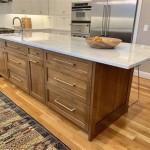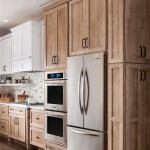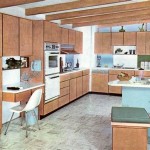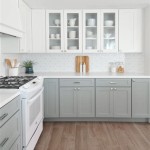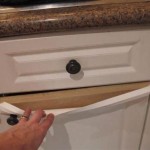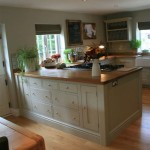How Much Sanding Before Painting Kitchen Cabinets?
Painting kitchen cabinets is a popular and cost-effective way to revitalize a kitchen without the expense of a full remodel. However, successful painting hinges on proper preparation, and sanding is a crucial step in this process. Determining the correct amount of sanding required can be challenging, as it depends on several factors, including the existing cabinet finish, the type of paint being used, and the desired final appearance. Insufficient sanding can lead to poor paint adhesion and a lackluster finish, while excessive sanding can damage the cabinet surfaces unnecessarily. This article provides a comprehensive guide to understanding how much sanding is needed before painting kitchen cabinets, ensuring a professional and durable outcome.
The primary purpose of sanding before painting is to create a surface that is receptive to the new paint. Without proper sanding, the paint may not adhere properly, leading to chipping, peeling, and an overall uneven finish. Sanding also removes any existing gloss from the previous finish, which can hinder the adhesion of new paint layers. Additionally, sanding helps to smooth out imperfections on the cabinet surface, such as minor scratches, dents, and dried drips of old paint. The resulting surface provides a clean and slightly textured base for the primer and paint to bond to effectively. Ultimately, achieving a smooth, durable, and aesthetically pleasing painted cabinet finish relies heavily on the quality and appropriateness of the sanding process.
Before commencing the sanding process, it's essential to gather the necessary materials and tools. This typically includes various grits of sandpaper, a sanding block or orbital sander, a tack cloth, a vacuum cleaner, and appropriate safety gear such as a dust mask and eye protection. Different grits of sandpaper are used for different purposes. Coarser grits, such as 80-120 grit, are effective for removing existing finishes and smoothing out significant imperfections. Medium grits, such as 150-180 grit, are suitable for general sanding and preparing the surface for primer. Fine grits, such as 220-320 grit, are used for creating an ultra-smooth surface between coats of primer or paint. The sanding block or orbital sander provides a uniform and efficient way to apply pressure while sanding, ensuring consistent results. The tack cloth and vacuum cleaner are essential for removing dust particles after sanding, which can interfere with paint adhesion. Finally, safety gear protects the user from inhaling dust and preventing eye irritation. Having all of these materials readily available will streamline the sanding process and contribute to a more successful paint job.
Key Point 1: Determining the Necessary Level of Sanding
The extent of sanding required is directly related to the existing condition of the kitchen cabinets. Cabinets that have a glossy or heavily lacquered finish will necessitate more aggressive sanding to remove the sheen and create a suitable surface for the paint to grip. In contrast, cabinets with a matte or previously painted finish may only require light sanding, often referred to as "scuff sanding," to roughen the surface and improve adhesion. If the cabinets have significant imperfections, such as deep scratches or dents, more extensive sanding might be necessary to smooth them out effectively. Careful assessment of the cabinet surfaces will dictate the appropriate sanding approach and the selection of suitable sandpaper grits.
For cabinets with a glossy finish, start with a medium-grit sandpaper (150-180 grit) to remove the majority of the sheen. Apply consistent pressure while sanding, moving in the direction of the wood grain if possible. Regularly check the progress to ensure the gloss is being effectively removed without gouging or damaging the surface. After removing the gloss, switch to a finer grit sandpaper (220 grit) to smooth out any remaining imperfections and prepare the surface for primer. This multi-step approach ensures that the glossy finish is adequately addressed without overly aggressive sanding that could harm the underlying material.
For cabinets with a matte or previously painted finish, light sanding with a fine-grit sandpaper (220-320 grit) is usually sufficient. The goal is simply to create a slightly rough texture that will allow the primer and paint to adhere properly. Avoid applying excessive pressure, as this can remove too much of the existing finish and potentially damage the cabinet surface. Focus on sanding evenly across the entire surface, paying particular attention to edges and corners. This gentle sanding approach is ideal for preparing surfaces that are already relatively smooth and free of significant imperfections.
Cabinets with significant imperfections, such as deep scratches, dents, or dried drips of old paint, require more targeted sanding. Use a coarser grit sandpaper (80-120 grit) to carefully sand down the imperfections until they are flush with the surrounding surface. Avoid sanding excessively in one area, as this can create unevenness. After addressing the imperfections, use a medium-grit sandpaper (150-180 grit) to smooth out the area and blend it with the rest of the cabinet surface. Finally, finish with a fine-grit sandpaper (220 grit) to prepare the surface for primer. This approach involves a layered sanding process to effectively address imperfections while ensuring a smooth and uniform final result.
Key Point 2: Techniques and Best Practices for Sanding
The sanding technique employed can significantly impact the outcome of the paint job. Whether using a sanding block or an orbital sander, it's essential to maintain a consistent pressure and motion. When sanding by hand with a sanding block, wrap the sandpaper tightly around the block and hold it firmly. Apply even pressure and move the block in a back-and-forth motion, following the grain of the wood if possible. Avoid concentrating pressure in one area, as this can create unevenness. Regularly check the sandpaper for clogs and replace it as needed to maintain optimal sanding efficiency.
When using an orbital sander, select the appropriate sanding pad for the task at hand. Ensure the sandpaper is securely attached to the sander before beginning. Turn on the sander and apply light, consistent pressure to the cabinet surface. Move the sander in a circular motion, overlapping each pass to ensure complete coverage. Avoid applying excessive pressure, as this can cause the sander to vibrate excessively and damage the surface. Regularly check the sandpaper for wear and replace it as needed. Orbital sanders are particularly useful for sanding large, flat surfaces, as they provide a uniform and efficient sanding action.
Dust removal is an integral part of the sanding process. After each sanding session, use a tack cloth to thoroughly wipe down the cabinet surfaces, removing any remaining dust particles. A tack cloth is a slightly sticky cloth that effectively picks up dust without leaving any residue. Fold the tack cloth and use a clean portion of the cloth for each pass. Alternatively, use a vacuum cleaner with a brush attachment to vacuum the cabinet surfaces. Pay particular attention to crevices and corners where dust tends to accumulate. Thorough dust removal is essential for ensuring proper paint adhesion and a smooth, flawless finish.
Safety precautions are paramount when sanding. Always wear a dust mask to prevent inhaling dust particles, which can be harmful to the lungs. Eye protection, such as safety glasses, is also essential to prevent dust from entering the eyes and causing irritation. Work in a well-ventilated area to minimize the inhalation of dust. Consider using a dust collection system with the orbital sander to further reduce dust exposure. Taking these safety precautions will help protect your health and ensure a more comfortable sanding experience.
Key Point 3: Post-Sanding Preparation and Painting
After completing the sanding process, several steps are necessary to prepare the cabinets for painting. Thoroughly clean the cabinet surfaces with a degreasing cleaner to remove any remaining dirt, grease, or oil. Ensure the cleaner is compatible with the cabinet material and follow the manufacturer's instructions carefully. Rinse the cabinets with clean water and allow them to dry completely before proceeding. This cleaning step is essential for ensuring proper paint adhesion and preventing contaminants from interfering with the finish.
Priming the cabinets is a crucial step that should not be skipped. Primer provides a uniform base for the paint to adhere to, improves paint coverage, and helps to seal any remaining imperfections. Choose a high-quality primer that is specifically designed for use on cabinets. Apply the primer in thin, even coats, following the manufacturer's instructions. Allow the primer to dry completely before proceeding to the painting step. Depending on the type of primer used, light sanding with a fine-grit sandpaper (220-320 grit) may be necessary after priming to create an ultra-smooth surface for the paint.
When selecting paint for kitchen cabinets, choose a durable and washable paint that is specifically formulated for use on cabinetry. Acrylic latex paints are a popular choice due to their durability, ease of application, and low odor. Oil-based paints are also an option, but they require more skill to apply and have a longer drying time. Apply the paint in thin, even coats, using a high-quality brush or sprayer. Allow each coat to dry completely before applying the next coat. Light sanding with a fine-grit sandpaper (220-320 grit) between coats can help to create a smoother finish. Multiple coats of paint are typically necessary to achieve full coverage and a durable finish.
Proper curing time is essential for ensuring the longevity and durability of the painted finish. Allow the painted cabinets to cure for the recommended time period, as specified by the paint manufacturer. Avoid using the cabinets excessively during the curing period to prevent scratches and damage. After the curing period, the cabinets will be ready for normal use and will provide years of beauty and functionality to the kitchen. Following these post-sanding preparation and painting steps will contribute to a professional-looking and long-lasting finish.

How To Paint Kitchen Cabinets A Step By Guide Confessions Of Serial Do It Yourselfer

How To Paint Kitchen Cabinets A Step By Guide Confessions Of Serial Do It Yourselfer

A Guide To Painting Kitchen Cabinets Norton Abrasives

A Guide To Painting Kitchen Cabinets Norton Abrasives

A Small Sander To Sand Kitchen Cabinets Before Painting House Mix

How To Paint Fake Wood Kitchen Cabinets Simple Made Pretty 2024

Refinish Kitchen Cabinets With Kilz Restoration Primer

How To Paint Kitchen Cabinets A Step By Guide Confessions Of Serial Do It Yourselfer

What You Need To Know Before Painting Cabinets The Palette Muse

Can You Paint Kitchen Cabinets Without Sanding
Related Posts

